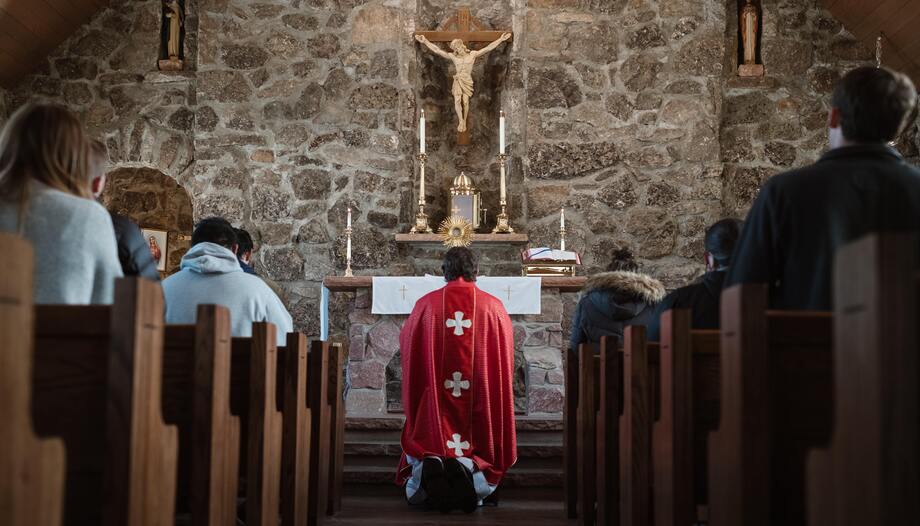Sacrilege is the desecration of a sacred thing, place or person, i.e., sacrilege involves the violation of the sanctity of things, places and persons dedicated to divine worship.
Therefore, sacrileges can be of three types: local, personal or real.
Let it be noted that the true sacrilege is when these sacred realities are destroyed or profaned as such, lacking the respect and honor due to God and to what is dedicated to God.
The royal sacrilege is manifested above all in the lack of respect for the sacraments, sacred vessels, images and in the theft of sacred things or goods.
On the other hand, the personal sacrilege is given mainly when violence is practiced against a sacred person especially with deeds and not only with words. Also when one sins against the vow of chastity, in which not only the person who has made the vow or professes celibacy sins, but also the accomplice.
Third, the local sacrilege is that which occurs when a person is killed in a sacred place or a sacred place is dedicated to a profane use or a robbery is committed in such a place.
Sacrilegio
The most frequent sacrilege is against the Most Holy Eucharist, by receiving it unworthily or by profaning the consecrated forms. It is the most serious sacrilege, because the Holy Eucharist is the holiest reality of the Church.
It is also necessary to avoid the desecration of the sacrament of penance, when the penitent confesses without due repentance or, also, if the confessor is moved by unhealthy curiosity or provokes the penitent to sin. It is fundamental for priests and religious, who are called to live above all for divine worship, to manifest the holiness of the sacraments in the way they celebrate or receive them. Consecrated persons manifest in the way they live what they do or do not carry within themselves.
A sacrilege is a specific sin against the virtue of religion, which promotes the glory of God and the sanctification of man. This sin must be confessed by specifying whether it is a thing, place or person. Specifically, sacrilege aggravates a specific sin, adding a new reason for sin and will be more or less serious in relation to the degree of sanctity of the thing, place or person.
For example, to kill a priest would be a doubly grave sin, for killing him and for being a priest. But it is not sacrilege to steal money from a priest, unless it is money received for a cultic purpose. However, it would always be a sin with an obligation to make restitution, especially if the amount was considerable. The penalty applied to grave sacrilege can be excommunication, which prevents one from falling back into such a sin, or another temporal penalty, when spiritual penalties are disregarded.
What to do after a sacrilege?
When a sacrilege occurs and is made public, the first and most urgent thing, in the case of sacred things, such as consecrated forms, images, sacred vessels, etc., is to try to recover these profaned sacred realities.
In the case of sacred places, such as temples, they should be restored if possible and convenient.
If the sacrilegious act has been carried out against a person, in this case it is necessary to rehabilitate him, purifying in some way and as far as possible the spaces where they have been found or the state in which the persons and sacred places are found. Then, these sacred realities must be put back in their proper places. But if the state of the consecrated forms or images makes it impossible to continue to serve their purpose, they must be deposited in worthy places where further desecration is impossible.
The Church's primary response to sacrilege is the redresswhich is the compensation for the injury done, based on the requirement of the virtue of justice, which obliges to give to each one what belongs to him.
Let us not forget that together with mercy there is always justice, in God and in us. Consequently, atonement or reparation for our sins is fundamental in the life of the Church and in the life of Christians, completing what is lacking in the Passion of Jesus Christ, not so much in relation to Christ, as is evident, but in relation to us. What is proper to atonement is to manifest divine holiness, which is also manifested in the holiness of things, persons and sacred places.
Redress is always interior, but exteriority is a necessary part of this just compensation due to the sacred. The sacramental is in itself something exterior that leads us to something interior.
The main act of atonement is obviously the worthy and devout celebration of the Holy Mass or adoration of the Blessed Sacrament; in fact, it is the normal atonement when it is a response to a sacrilege committed against the Holy Eucharist, which is the great treasure of the Church.
A sacrilege committed against sacred images, sacred vessels, relics of saints, sacred vestments, etc. is repaired by acts that in some way restore their sacred value.
Caring for the sacred
I conclude this brief reflection with an invitation to priests and Christian communities to properly apply the classical principle: holy things must be treated in a holy manner.
The devout priest celebrates devoutly, while the worldly priest becomes the protagonist, hiding the Lord. There are three main moments in the celebration of Holy Mass, namely, the Offertory, the Consecration and Communion. The bread and wine offered are in some way sacred. The consecrated bread and wine contain the presence of the body, soul and divinity of Christ; the bread received is the very body of Jesus Christ.
Let us see to it that not even the smallest particle is ever lost, always using the most devout way of receiving it. The priest, in the way he celebrates and even in the way he dresses, must show his sacred character.
Penitentiary in Santa Maria Maggiore, Rome







